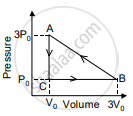Advertisements
Advertisements
प्रश्न
An ideal gas of volume 2 L is adiabatically compressed to (1/10)th of its initial volume. Its initial pressure is 1.01 x 105 Pa, calculate the final pressure. (Given 𝛾 = 1.4)
उत्तर
Given:
Vi = 2 L, Vf = `("V"_"i")/10 ⇒ ("V"_"i")/("V"_"f") = 10, "P"_"i" = 1.01 xx 10^5` Pa, γ = 1.4
To find: Final pressure (pf)
Formula: For adiabatic process: `"p"_"f" "V"_"f"^γ = "p"_"i""V"_"i"^γ`
Calculation:
From formula,
pf = pi × `("V"_"i"/"V"_"f")^γ`
= 1.01 × 105 × (10)1.4
= antilog {log (1.01) + 1.4 × log (10)} × 105
= antilog {0.0043 + (1.4 × 1)} × 105
= antilog {1.4043} × 105
= 2.537 × 106 = 25.37 × 105 Pa
The final pressure (pf) is 25.37 × 105 Pa
संबंधित प्रश्न
Answer in brief.
Why should a Carnot cycle have two isothermal two adiabatic processes?
What is a thermodynamic process?
State the assumptions made for thermodynamic processes.
Differentiate between the reversible and irreversible processes.
Explain work done during a thermodynamic process.
Explain thermodynamics of the adiabatic process.
When food is cooked in a vessel by keeping the lid closed, after some time the steam pushes the lid outward. By considering the steam as a thermodynamic system, then in the cooking process
Give an expression for work done in an isothermal process.
Apply first law for an isothermal process.
Apply first law for an adiabatic process.
Apply first law for an isobaric process.
Draw the PV diagram for the adiabatic process.
What is meant by a reversible and irreversible processes?
Can the given heat energy be completely converted to work in a cyclic process? If not, when can the heat can completely converted to work?
Derive the work done in an isothermal process.
Draw the TP diagram (P-x axis, T-y axis), VT(T-x axis, V-y axis) diagram for
- Isochoric process
- Isothermal process
- Isobaric process
For a given ideal gas 6 × 105 J heat energy is supplied and the volume of gas is increased from 4 m3 to 6 m3 at atmospheric pressure. Calculate
- the work done by the gas
- change in internal energy of the gas
- graph this process in PV and TV diagram
A monoatomic gas of pressure p having volume V expands isothermally to a volume 2V and then adiabatically to a volume 16V. The final pressure of the gas is ____________.
`("ratio of specific heats" = 5/3)`
Among the amount of heat absorbed and the amount of work done by a system, ______
One mole of an ideal gas with `gamma` = 1.4 is adiabatically compressed so that its temperature rises from 27° C to 47° C. The change in the internal energy of the gas is (R = 8.3 J/mol.K) ____________.
In which of the following processes, beat is neither absorbed nor released by a system?
In an isothermal process, the volume of an ideal gas is halved. One can say that ____________.
An ideal gas is compressed to half its initial volume by means of several processes. Which of the process results in the maximum work done on the gas?
In the figure shown here, the work done in the process ACBA is ______.

When an inflated ballon is suddenly burst, why is the emerging air slightly cooled?
Explain how can a gas be expanded at constant temperature.
